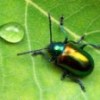
The port at Mobile, Alabama, photographed from across the bay.
The port city of Mobile, Alabama holds special significance for students of ant science. Jo-anne and I took a weekend trip down to the gulf coast in January, and as we are both myrmecologists we felt compelled to stop and take a few photographs. Not only is Mobile the childhood home of ant guru E. O. Wilson, but the city's docks have been the point of introduction into North America for some notorious pest ants. We'd have neglected our intellectual heritage to just drive through.

Mobile's busy international commerce has made it ground zero for several biological invasions, mostly stowaway species carried accidentally in cargo.  The most famous is the red fire ant Solenopsis invicta, but it is likely that the port also welcomed the South American big-headed ant Pheidole obscurithorax and the rover ant Brachymyrmex patagonicus. Below are portraits of Mobile's evil ant spawn:

Solenopsis invicta

Pheidole obscurithorax

Brachymyrmex patagonicus
Oddly, all three of these ants are from the Paraguay river basin. It's as if Mobile is a wormhole through which the South American ant fauna transports itself for reassembly in the northern hemisphere.

Thank you for sharing these nice pics. The two tiny Rover Ants enjoying their sugary meal are quite tiny. A pest who looks really nice, a bit like so many small rodents...
When rewiring a light post in my front yard in Mobile, Alabama, hundreds of very large ants came pouring out of the post from underground. They occasionally jumped and it made a sort of clicking noise. Their actions were aggressive and obviously agitated, yet not toward me as I kept my distance. They were very fast and had a sort of odd shaped head, not being round. They were quite dark in color and they quickly disappeared into the grass below. I should have captured a few of them for identification purposes, but that was not foremost on my mind at the time.
I did not recognize these ants, even having graduated in Biology from the University of South Alabama a few years ago. I did a few searches on the internet and the closest description and photographs were that of the Myrmeciinae Myrmecia. I found no information on this ant having taken residence in North America. If you have any information on what I described, please comment and I will be notified.